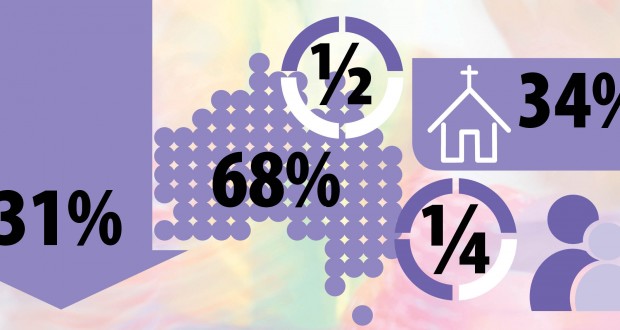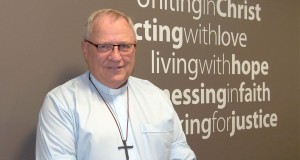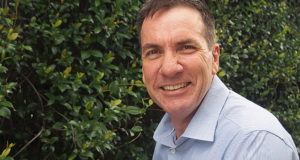Data from the 2013 census of the Uniting Church in Australia has been released just in time for its 37th anniversary. It reveals an organisation facing some tough decisions. Dianne Jensen reports.
Thirty-seven years down the track, Australia’s first home-grown church is facing a mid-life crisis familiar to any adult wondering where the kids have gone and what lies ahead. The newly released 2013 National Church Life Survey (NCLS) census data about the Uniting Church in Australia reveals an organisation facing some tough questions about the future.
The census was commissioned by Assembly President Rev Dr Andrew Dutney to collect information about ministry agents, church location and attendance, and other features of congregational life such as internal activities and community outreach.
In brief, the data reveals 2078 church locations across Australia, a decrease of 31 per cent since 1990, and a weekly worship attendance of 97 200 (including 12 500 children), a decline of 40 per cent.
The median weekly attendance is the highest in Queensland (59 people per church, including eight children), and the Queensland Synod has a relatively high proportion of churches in the 50-74 size bracket (35 per cent of churches).
These days our churches are better known in their communities for visiting and emergency relief services than for the social rituals of weddings, funerals and baptisms which have largely disappeared.
The sobering statistics will come as no surprise to congregations across Australia, many of whom are already dealing with declining attendance and a dearth of ministerial agents.
Reinventing church
Andrew Dutney agrees that we must acknowledge that both church and society have changed since the 1970s.
He points out that the Uniting Church in Australia continues to be a significant presence across Australia, with over 2000 congregations. More than four in ten of these congregations are in small rural areas, and Andrew suggests that we may learn important lessons from their resilience and flexibility.
“Many of [our rural congregations] are lay-led congregations that have found innovative ways to be present and effective in their communities—in contrast to the withdrawal of so many organisations, businesses and services during the long rural decline.”
The question, he says, is how Assembly might go about resourcing the congregations of this new century with regulations that reflect their actual shape and circumstances.
Queensland Moderator Rev Kaye Ronalds also has first-hand experience of how some rural congregations have successfully maintained a Christian presence in their communities. Kaye has visited many congregations celebrating milestones such as a centenary, as well as four congregations that have decided to close their doors.
“I think the rural congregations have been facing these changes for 15 years. Many find ways of adapting to having fewer clergy on the ground and they sit together to decide what they need to do to be the people of God. That does not always mean continuing to have worship Sunday by Sunday,” says Kaye.
“We need to have some conversations about what kind of church we want to be. On the one hand we have many clergy who are not prepared to move from the ‘green edge’ [on the coast] and yet our community services in Queensland have a presence in 400 locations, many of which are rural or remote.”
Doing nothing is not an option
Rev Dave Baker, Moderator-elect of the Queensland Synod, is blunt in his assessment of the challenges ahead.
“We can grieve over the loss of the profile that we once had, but there is a time when you say, right, there is still a call, there is still an opportunity,” says Dave. “The question before us is a stewardship question; are we prepared to re-deploy the precious things we have for the sake of the mission or do we want to stay where we are?”
In an environment which is no longer benign to people of faith, Dave believes that providing quality leadership is critical.
“Let’s understand what is needed and let’s apply ourselves to addressing that through the shaping and forming of leadership, lay and ordained, the resourcing of church councils and lay leaders in their ministry and their understanding of the gospel, and the capacity to be more flexible around how we deploy our assets.”
While we won’t be the same church in 20 years, we do have the opportunity to be a better church; “a church that actually provides a place of strength, of identity, of belonging, an alternative vision of what human society can be like, an encouraging place and a safe haven,” says Dave.
Members of the Lay Forum, an organisation aimed at giving a voice to progressive thinkers in the Uniting Church, believe that we need to take a critical look at our church culture.
“Changing social demographics are faced by all organisations and can be addressed effectively with a significant focus on the uniqueness of each Australian community,” says Executive Officer Dr Paul Inglis. “But more significantly, and not addressed seriously, are the generally changing world views as a result of raised standards of education, greater critical thinking and consumer awareness. The age of compliant and uncritically accepting audiences in churches is well and truly over in this era of advanced rational thinking.
“The Uniting Church, of all denominations, offers great possibilities for diverse thinking, and for understanding and connection to the real world,” he says.
“It has within its polity and philosophy an intentional goal to be adaptive, focussed on bringing Jesus into the 21st century and an openness to change. It is poised for change and many are ready to move forward. It simply needs to liberate thinking and participation at community level, so this can happen before the critical mass of talent and intelligence further diminishes.”
More than counting heads
Perhaps the most pressing issue raised by the census is the demographic time bomb. One quarter of churches have no children, and another half have between one and nine children in the congregation.
At the other extreme, over a third of active ministers are at least 60 years of age, and only six in 100 are under 40 years of age.
Moreton Rivers presbytery youth, children’s and families coordinator Alison Cox says our attitude to young people needs to go beyond “wanting them to be on our property to actually engaging in meaningful relationships”.
“I become fearful when we continue to ‘wait for young people to be old enough to contribute in a meaningful way’, by which time they’ve left and found somewhere else that actually does listen, and engage, and recognise the valuable contribution they make to the whole community of God.”
She believes that the church needs to provide better support and proactive mentoring.
“I don’t think we expect young people to consider entering ministry—often it takes someone suggesting or affirming or encouraging or prompting someone to hear God’s call on their life and take that next step. If no one is having those conversations with young people in our churches or giving them opportunities to learn and grow then they’ll find other places to share their gifts and skills and time.”
Brisbane Bayside Uniting Church minister Rev Lu Senituli says the outlook is far from bleak for multicultural congregations and ministers. Lu is a member of the Synod Standing Committee and the Assembly Doctrine Group as well as the convenor of the Assembly of Confessing Congregations Cross Cultural Commission.
Data from Uniting Aboriginal and Islander Christian Congress and minority migrant-ethnic churches was largely missing from the census, but Lu says that these congregations are in fact growing.
“The migrant-ethnic based communities and their associated multicultural congregations are not declining congregations with a notable absence of children, youths and young adults. There are significant numbers of multicultural congregations here in Brisbane who are faced with the challenge of finding more suitable worship space for their growing numbers.”
Lu believes that the relegation of the Christian faith to the private and personal space has muted our voice.
“The church needs to regain confidence in its Lord Jesus Christ and his gospel for the world, and to hold to the moorings of the Christian faith in an ever-changing pluralistic, post-modern, multicultural, multi-faith Western society.”
 JourneyOnline
JourneyOnline








This article presents to your readership the greatest challenge ever to the Uniting Church in Australia, and requires research and prayer by every member.
Dr Eddie Gibbs, acknowledged as an international expert on the subject of church growth, has found, generally, mega churches are not the answer. Within a decade, internal friction at leadership level leads to their closure. However, because they had the best specialist ministries team, other churches in the area were closed leaving areas churchless.
We have the resources at all levels to produce the required result as demanded by Jesus in the Parable of the Coins, and are doing so in some congregations, but in others they are being deployed to produce the one coin result because of introversion. Let us have the magnanimity of outlook demanded in the Gospels, a Uniting Church collectively embracing change and 21st century spiritual and pastoral needs for all the family.
According to the National Church Life Survey, attendance at Uniting churches dropped 11% from 1991 to 1996, 11% from 1996 to 2001 and 40% from 1991 to 2011. So it looks like a trend of losing 11% every 5 years for 20 years. The surveys show the Uniting church are losing attenders faster than any other church. A church that had 250,000 attending in 1977 now has 97,000 and if the 20 year trend contines will be under 40,000 by 2050. What has caused such a dramatic long term decline, and a decline larger than all other churches?